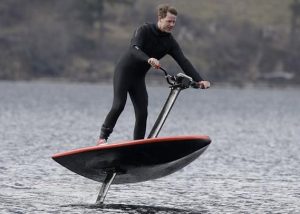Motorized Hydrofoil Board: How Does a Motorized Hydrofoil Board Work?
A Motorized Hydrofoil Board, a marvel of modern engineering, merges the thrill of surfing with advanced technology to create a completely new water sport experience. This guide explores the mechanics behind how a motorized hydrofoil board operates, providing insights into the components and principles that allow these innovative devices to glide above the water.

The Principles of Hydrofoiling
At the core of a motorized hydrofoil board's operation is the concept of hydrodynamic lift, similar to the aerodynamic lift that allows airplanes to fly. This lift is generated by the board's hydrofoil, which functions underwater.
Hydrofoil Design
- Hydrofoil Shape: The hydrofoil has wings designed to cut through water. As the board gains speed, water flows over these wings, creating lift that elevates the board above the surface, reducing drag and allowing for smoother, faster rides.
- Lift Generation: The lift is directly proportional to the square of the velocity of the water passing over the wings. This means that as the board's speed increases, the amount of lift generated significantly increases, requiring only a minimal speed to maintain elevation above the water.
Key Components
Electric Motor and Propulsion System
- Power Output: The electric motor provides the thrust needed to propel the board forward and generate sufficient speed for the hydrofoil to create lift. Motors typically range from 4kW to 6kW, capable of pushing the board to speeds up to 25mph (40km/h).
- Efficiency and Speed Control: Riders can precisely control the speed through a wireless remote, adjusting the power output of the motor to manage the board's elevation and speed.
Battery and Energy Supply
- Capacity and Ride Duration: High-capacity lithium-ion batteries power the motor, offering ride times of 1 to 2 hours on a full charge, depending on usage patterns, rider weight, and conditions.
- Recharge Time and Lifespan: Battery technology ensures fast recharge times and a long lifespan, with most batteries providing several hundred charge cycles before experiencing significant capacity loss.
Construction and Materials
- Durability and Performance: The board and hydrofoil are often made from lightweight, high-strength materials like carbon fiber, optimizing durability, performance, and ease of maneuverability.
- Design Specifications: Manufacturers offer boards in various sizes and designs, catering to different skill levels and preferences. The hydrofoil's design, including wing size and shape, can be tailored to affect lift, speed, and stability.
Cost Considerations
Investing in a motorized hydrofoil board involves considering both the initial purchase price and ongoing maintenance costs:
- Initial Purchase: Prices range significantly, from $6,000 to $12,000, influenced by the board's technology, materials, and brand.
- Maintenance and Repairs: While designed for durability, the high-tech components and materials may incur maintenance costs, including battery replacement and hydrofoil repairs.
Conclusion
The motorized hydrofoil board offers an exhilarating, futuristic surfing experience, flying above the water's surface with speed and grace. Understanding the technology and mechanics behind these boards is key to appreciating their capabilities and making an informed decision when considering a purchase. Whether you're a water sports enthusiast seeking new thrills or simply intrigued by the fusion of technology and sport, a motorized hydrofoil board represents the pinnacle of aquatic innovation.
